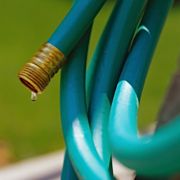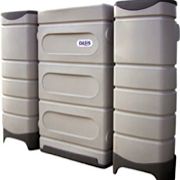This is the fifth article in a 6 part series on Saving Water. See part 1 on measuring your tap water, part 2 on benefits of a water tank, part 3 on gutters and drains and part 4 on saving water around the house. Living in Sydney, Australia I’m acutely aware of the value of this precious resource.
When it comes to conserving water, this is the big one. As greywater comprises around three quarters of a household’s waste water, it’s well worth looking at. After all, saving water = saving money.
What is Greywater?

First, a definition.
The water you see around the house can generally be classified as one of three types –
White / fresh water : this is the clear water you drink.
Greywater / graywater : this water contains a small amount of dirt, and is water that has been previously used within the house. The water which leaves the washing machine, for example.
Blackwater : this is the waste water from the toilet.
Just remember the greywater = previously used part, and you’ll begin to see just how much of the stuff there is available.
What can greywater be used for?
At this point you may be wondering exactly what you can do with all of this slightly cloudy water. After all, it contains everything that was washed off your hands, dishes, clothes and so on.
There are two answers to this, as you’ll quickly see in the sections on collecting greywater. It can either be used as-is for a few things, or cleaned up and re-used in any number of ways.
Using greywater as-is
There are a few ways to collect the water in the house, and use it on an appropriate (more on that in a minute) part of the garden. These are all free, and are things that anyone can start doing today. Excellent.
The Bucket Method
 In an earlier article on saving water around your house, I mentioned the idea of putting a bucket in the shower, specifically to catch the cold water that comes out before things start to warm up. Once the bucket is full, put it to one side until after your shower; and then pour it on the garden.
In an earlier article on saving water around your house, I mentioned the idea of putting a bucket in the shower, specifically to catch the cold water that comes out before things start to warm up. Once the bucket is full, put it to one side until after your shower; and then pour it on the garden.
An alternative is to use this bucket of water to flush the toilet. Simply pour the water into the bowl, instead of flushing. It’ll automatically flush everything away.
NB : Having a bath? The same thing applies. Grab the bucket afterwards.
Simple redirection
Several appliances (notably washing machines, air-conditioning units and dehumidifers) enable a hose to be connected to the back (often just a regular garden hose) to redirect the waste water. Simply attach a hose to the back of the machine, and point it to an appropriate part of the garden. Perfect.
What is an ‘appropriate’ part of the garden?
In the examples above, much of the water was already clean to begin with; putting it on any area of the garden is fine.
With greywater, however, some plants enjoy it more than others. If you have a choice, use it to water :
Lawns : most grasses are fine with greywater. If the greywater is particularly cloudy, just alternate its use with fresh water.
Trees and large shrubs : the majority of these are fine. Greywater tends to be slightly alkaline, so trees such as Oaks do particularly well with it.
Roses : roses also tend to enjoy slightly alkaline conditions, so greywater is perfect.
Alkaline-loving plants : whilst roses are perhaps the best known, a number of other alkaline-friendly plants enjoy a bit of greywater. These include bougainvilleas, agapanthus and honeysuckle.
As a general rule, use the greywater for ornamental plants rather than those you eat. Whilst there are exceptions, this will keep things running smoothly.
NB : If the garden is physically lower than the machine spitting out the water, you won’t even need a pump. Just plug in and enjoy.
Things to avoid
The vegetable garden : although some vegetables really don’t mind it, the majority don’t like it at all.
Irrigation systems with small holes at some point (even the sprinkler heads) : these occasionally become clogged with the larger material in greywater.
Cleaning up the greywater
 As I mentioned earlier, the other way to handle greywater is to collect it; and then clean it up a little. When people talk of the costs associated with greywater, this filtration is usually involved. Effective, yes; but not exactly cheap. Yet.
As I mentioned earlier, the other way to handle greywater is to collect it; and then clean it up a little. When people talk of the costs associated with greywater, this filtration is usually involved. Effective, yes; but not exactly cheap. Yet.
Why clean the greywater?
By filtering the greywater, the clean water produced can be re-used to flush toilets, run the dishwasher, fill the washing machine and so on. It can also be stored for much longer periods of time.
How is this done?
There are a number of systems on the market for doing this (collection, filtration and storage), with the expected range of appearances and costs. These systems generally work by :
Collection and filtration : the water is taken as it goes down the drain, and redirected into a filtration system.
There’s absolutely no difference in appearance at this point – in fact your neighbours may already be doing it. You’d never know.
Storage : once the majority of impurities have been removed, the water is directed to a storage tank.
Re-use : the storage tank is connected to the wet rooms of the house. Whenever the toilet is flushed, or the washing machine is used (as well as many more devices) – this cleaned greywater is used.
NB : If there isn’t quite enough water in the storage tank, the regular supply of fresh water is automatically used.
Keeping the greywater clean, naturally
As you can see, greywater is simply a mix of the stuff you pour down the drain (except the toilet, of course). No matter whether you’re using a bucket or a cutting-edge filtration system; life will be much, much easier if the water is a little cleaner to begin with.
To keep the greywater as clean as possible, take a look at your household cleaning products. There are a number of items that will do a superb cleaning job (particularly shampoos, laundry and dishwashing detergents); as well as keeping your plants happy. If you’re putting greywater on the garden, these are well worth considering.
Of course, all products vary in their cost, appearance and effectiveness – ask your neighbours what they are using. Regardless of the brand, however, here are a few general guidelines :
- use products which are phosphate free
- use products which are low in sodium
- use products which state that all of their ingredients are biodegradable
- use products which are concentrated
- use products which can be used in cold water
Although this sounds like a bit of work, most of the products with ‘green‘ names will tick these boxes. And your garden will look great.
Final thought on using greywater
When it comes to saving water, the use of greywater is an obvious choice. Whether you’re using a bucket or a complete filtration system; using greywater just makes sense.
Next week I’ll be taking a look at the many things possible when you’re building a new house, or renovating an existing one. Self-sustainability (at least as far as water is concerned) really isn’t as difficult as you might think.
In the meantime, check out some of the previous articles in this series. Enjoy.
Comments are closed.